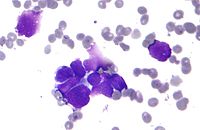
Photo from wikipedia
Epidermal growth factor receptor tyrosine kinase inhibitors (EGFR-TKIs) are the most important chemotherapeutics for non-small-cell lung cancer (NSCLC) therapy. The resistance to EGFR-TKIs is one of the biggest obstacles to… Click to show full abstract
Epidermal growth factor receptor tyrosine kinase inhibitors (EGFR-TKIs) are the most important chemotherapeutics for non-small-cell lung cancer (NSCLC) therapy. The resistance to EGFR-TKIs is one of the biggest obstacles to NSCLC outcome. In this study, taking advantage of phospho- and proximal proteomic techniques, we analyzed the network rearrangement in cell lines responding to AZD9291 treatment and found that cell-cell adhesion was dramatically enhanced in AZD9291-resistant cells. Further analysis revealed that protein tyrosine kinase 7 (PTK7) expression was significantly elevated. Knockdown or overexpression assays showed that PTK7 played a critical role in improving cell adhesion, which enhanced drug resistance. Because PTK7 is a membrane-localized pseudokinase, the proximal labeling probe BirA* was fused to reveal PTK7-interacting proteins. We found that PTK7 interacted with and stabilized NDRG1, which is located predominantly adjacent to adherens junctions. Downregulation of PTK7 or NDRG1 eliminated the resistance of H1975-resistant (H1975-R) and PC9-resistant (PC9-R) cells to AZD9291, suggesting that the PTK7-NDRG1 axis might be a potential target to eliminate the EGFR-TKI resistance during NSCLC therapy.
Journal Title: ACS chemical biology
Year Published: 2022
Link to full text (if available)
Share on Social Media: Sign Up to like & get
recommendations!